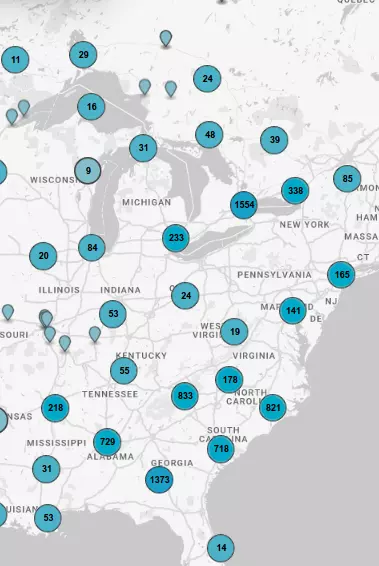Michigan State Ferry System / Michigan State Car Ferries
In 1923, in response to increasing automobile traffic, the Michigan Highway Department established the Michigan State Ferry System to connect the Upper and Lower Peninsulas by transporting...
- michigan
- michigan his...
St. John Evangelical Lutheran / Amelith
German missionary Pastor Ferdinand Sievers organized St. John Church in June 1852 to serve a colony of German migrants, some fleeing the turmoil that followed the European revolutions of 1848....
- michigan
- michigan his...
Dougherty Mission House / Rushmore House and Inn
Peter Dougherty arrived on Mackinac Island in 1838, planning to establish a Presbyterian mission to the Ojibwe and Odawa tribes in northern Michigan. He selected the Grand Traverse Bay area and...
- michigan
- michigan his...
Underhill Store
Isaac M. Dimond purchased four thousand acres of land here in 1837. In 1850 he built a dam on the Grand River to furnish power for a sawmill and gristmill, platting the village of Dimondale...
- michigan
- michigan his...
Walker Tavern/Walker Tavern
This tavern was built around 1832. Stagecoach passengers stopped here for lodging and food as they traveled between Detroit and Chicago on the Chicago Road (later US-12) and on the La...
- michigan
- michigan his...
Olivet College
On February 24, 1844, the Reverend John J. “Father” Shipherd and thirty-nine followers arrived by ox-cart on this wilderness hilltop, driving their herds before them. They felt God had directed...
- michigan
- michigan his...
The Strand / Theatre District
On April 21, 1921, this building opened as the Strand Theater and Arcade. The two thousand-seat theater boasted one of the largest vaudeville stages in the state and a screen for viewing motion...
- michigan
- michigan his...
Scout Barracks / Parade Ground
In 1929, Park Commissioner Roger Andrews invited eight Eagle Scouts, including future President Gerald Ford, to serve as the “Governor’s Honor Guard” and tour guides at Fort Mackinac....
- michigan
- michigan his...
New Fort Brady
When Sault Ste. Marie expanded and its canal was widened, the riverfront site of Fort Brady was abandoned for a higher, more strategic site selected by General Philip Sheridan. Work began in 1886,...
- michigan
- michigan his...
Menominee Area
This was the home of the Menominee Indians. Nicolet, the French explorer, visited them in 1634 on his futile search for Cathay. Conflict over fishing rights brought on the Sturgeon War...
- michigan
- michigan his...
Michigan Pharmacists Association
On November 14, 1883, seventy-seven druggists met in the State Capitol to organize the Michigan State Pharmaceutical Association. Jacob Jesson of Muskegon led the effort to establish...
- michigan
- michigan his...
Michigan at Tebbs Bend / Michigan at Tebbs Bend
During the first week of July 1863, while the people of the North and the South focused their attention on Gettysburg and Vicksburg, five Michigan companies defended the bridge across the Green...
- michigan
- michigan his...
Gogebic Iron Range
The Gogebic was the last of the three great iron ore fields opened in the Upper Peninsula and northern Wisconsin. Beginning in 1848 with Dr. A. Randall, federal and state geologists had mapped the...
- michigan
- michigan his...
The Famous George Burns Pool Table
Pere Marquette Railroad Depot
In 1891-92 the Chicago and West Michigan Railway, precursor to the Pere Marquette Railroad, extended the line between Traverse City and Petoskey through Spencer Creek. William Alden Smith,...
- michigan
- michigan his...
Hibbard Tavern
Aaron Phelps, pioneer settler and first postmaster of Milford, built this Greek Revival residence between 1836 and 1838. It was one of the first frame structures erected in the village. New...
- michigan
- michigan his...
Gros Cap and St. Helena Island
French fishermen who came to Gros Cap (on the shore below) early last century also participated in its offshore settlement, St. Helena Island, where ships obtained wood fuel and other...
- michigan
- michigan his...
Territorial Road
One of the three great east-west routes of pioneer days, the Territorial Road from Detroit to St. Joe tapped the rich lands of the second “tier” of counties. Approved in 1829, the road was...
- michigan
- michigan his...
Oscoda County / Oscoda County Courthouse
Under the Saginaw Treaty of 1819, the Chippewa tribes ceded 6 million acres to the United States, including the land comprising present-day Oscoda County, which was set off from Alcona County...
- michigan
- michigan his...
Norwayne Subdivision / Norwayne Subdivision
In 1942, the National Housing Agency designed and built the Norwayne Subdivision to provide rental housing for nearby WWII defense factory workers. It cost $12 million dollars and was then...
- michigan
- michigan his...
